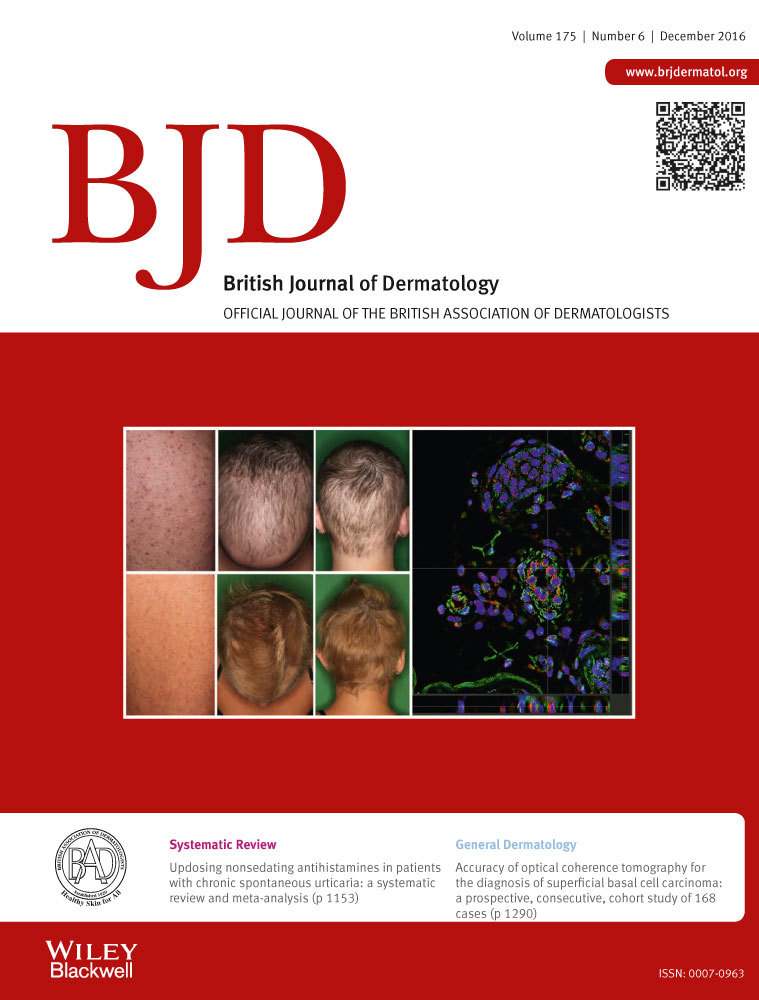Rescue therapy with anti-programmed cell death protein 1 inhibitors of advanced cutaneous squamous cell carcinoma and basosquamous carcinoma: preliminary experience in five cases
L. Borradori
Moores Cancer Center, University of California San Diego, 3855 Health Sciences Drive, La Jolla, CA, 92093 U.S.A.
Department of Dermatology, University Hospital, University of Bern, Freiburgstrasse, 3010 Bern, Switzerland
Search for more papers by this authorB. Sutton
Moores Cancer Center, University of California San Diego, 3855 Health Sciences Drive, La Jolla, CA, 92093 U.S.A.
Search for more papers by this authorP. Shayesteh
Moores Cancer Center, University of California San Diego, 3855 Health Sciences Drive, La Jolla, CA, 92093 U.S.A.
Search for more papers by this authorCorresponding Author
G.A. Daniels
Moores Cancer Center, University of California San Diego, 3855 Health Sciences Drive, La Jolla, CA, 92093 U.S.A.
Correspondence: Gregory A. Daniels.
E-mail: [email protected]
Search for more papers by this authorL. Borradori
Moores Cancer Center, University of California San Diego, 3855 Health Sciences Drive, La Jolla, CA, 92093 U.S.A.
Department of Dermatology, University Hospital, University of Bern, Freiburgstrasse, 3010 Bern, Switzerland
Search for more papers by this authorB. Sutton
Moores Cancer Center, University of California San Diego, 3855 Health Sciences Drive, La Jolla, CA, 92093 U.S.A.
Search for more papers by this authorP. Shayesteh
Moores Cancer Center, University of California San Diego, 3855 Health Sciences Drive, La Jolla, CA, 92093 U.S.A.
Search for more papers by this authorCorresponding Author
G.A. Daniels
Moores Cancer Center, University of California San Diego, 3855 Health Sciences Drive, La Jolla, CA, 92093 U.S.A.
Correspondence: Gregory A. Daniels.
E-mail: [email protected]
Search for more papers by this authorAbstract
Linked Comment: Soura et al. Br J Dermatol 2016; 175:1150–1151.
Supporting Information
| Filename | Description |
|---|---|
| bjd14642-sup-0001-FigS1.docxWord document, 976.7 KB | Fig S1. Case 2. Ulcerating cutaneous squamous carcinomas with local invasion and destruction of the right orbital region (a). Four months after starting an anti-programmed cell death protein 1 inhibitor, there is partial tumour response with reduction of the size of the ulceration and of the infiltration, particularly at the periphery of the tumour (arrows) (b). |
| bjd14642-sup-0002-TableS1.docxWord document, 87.3 KB | Table S1. Summary of genomic alterations detected in the tumours of the five included patients by comprehensive cancer genomic test. |
Please note: The publisher is not responsible for the content or functionality of any supporting information supplied by the authors. Any queries (other than missing content) should be directed to the corresponding author for the article.
References
- 1Karia PS, Han J, Schmults CD. Cutaneous squamous cell carcinoma: estimated incidence of disease, nodal metastasis, and deaths from disease in the United States, 2012. J Am Acad Dermatol 2013; 68: 957–66.
- 2Jarkowski A 3rd, Hare R, Loud P et al. Systemic therapy in advanced cutaneous squamous cell carcinoma (CSCC): the Roswell Park experience and a review of the literature. Am J Clin Oncol 2014; DOI: 10.1097/COC0000000000000088.
- 3Stratigos A, Garbe C, Lebbe C et al. European Dermatology Forum (EDF); European Association of Dermato-Oncology (EADO); European Organization for Research and Treatment of Cancer (EORTC). Diagnosis and treatment of invasive squamous cell carcinoma of the skin: European consensus-based interdisciplinary guideline. Eur J Cancer 2015; 51: 1989–2007.
- 4Sharma P, Allison JP. The future of immune checkpoint therapy. Science 2015; 348: 56–61.
- 5Mahoney KM, Freeman GJ, McDermott DF. The next immune-checkpoint inhibitors: PD-1/PD-L1 Blockade in Melanoma. Clin Ther 2015; 37: 764–82.
- 6Darb-Esfahani S, Kunze CA, Kulbe H et al. Prognostic impact of programmed cell death-1 (PD-1) and PD-ligand 1 (PD-L1) expression in cancer cells and tumor-infiltrating lymphocytes in ovarian high grade serous carcinoma. Oncotarget 2016; 7: 1486–99.
- 7Rizvi NA, Hellmann MD, Snyder A et al. Cancer immunology. Mutational landscape determines sensitivity to PD-1 blockade in non-small cell lung cancer. Science 2015; 348: 124–8.
- 8Le DT, Uram JN, Wang H et al. PD-1 blockade in tumors with mismatch-repair deficiency. N Engl J Med 2015; 372: 2509–20.
- 9Al-Rohil RN, Tarasen AJ, Carlson JA et al. Evaluation of 122 advanced-stage cutaneous squamous cell carcinomas by comprehensive genomic profiling opens the door for new routes to targeted therapies. Cancer 2016; 122: 249–57.
- 10Clark RA, Huang SJ, Murphy GF et al. Human squamous cell carcinomas evade the immune response by down-regulation of vascular E-selectin and recruitment of regulatory T cells. J Exp Med 2008; 205: 2221–34.
- 11Chang AL, Kim J, Luciano R et al. A case report of unresectable cutaneous squamous cell carcinoma responsive to pembrolizumab, a programmed cell death protein 1 inhibitor. JAMA Dermatol 2016; 152: 106–8.
- 12Eisenhauer EA, Therasse P, Bogaerts J et al. New response evaluation criteria in solid tumours: revised RECIST guideline (version 1.1). Eur J Cancer 2009; 45: 228–47.
- 13Cao Y, Zhang L, Kamimura Y et al. B7-H1 overexpression regulates epithelial–mesenchymal transition and accelerates carcinogenesis in skin. Cancer Res 2011; 71: 1235–43.
- 14Ritprajak P, Azuma M. Intrinsic and extrinsic control of expression of the immunoregulatory molecule PD-L1 in epithelial cells and squamous cell carcinoma. Oral Oncol 2015; 51: 221–8.
- 15Naidoo J, Page DB, Li BT et al. Toxicities of the anti-PD-1 and anti-PD-L1 immune checkpoint antibodies. Ann Oncol 2015; 26: 2375–91.




